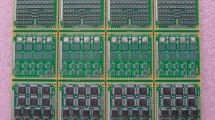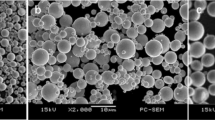Abstract
Metallic whiskers of pure lead (Pb) have been observed in the solder of several types of transistors. The conditions that lead to these whiskers were evaluated, including characterization of the whisker lengths and whisker density as a function of time and temperature. The potential cause and impact they would have on the reliability of electronics has been investigated. Based on these results, it is hypothesized that these whiskers may be caused by the relief of residual stresses that are created during the evolution of Au-In and/or Au-Pb intermetallic compounds or, possibly, by a decomposition of the AuPb3 phase. Due to their small size, the Pb whiskers that were observed were considered to not be a reliability concern, but similar or larger Pb whiskers could cause electrical failure in some applications.












Similar content being viewed by others
References
P. Zhang, Y. Zhang, and Z. Sun, Spontaneous Growth of Metal Whiskers on Surface of Solids: A Review, J. Mater. Sci. Techol., 2015, 31(7), p 675–698
R.S. Wagner and W.C. Ellis, Vapor–Liquid–Solid Mechanism of Single Crystal Growth, Appl. Phys. Lett., 1964, 4(89), p 89–90
J. Muller, M. Schierling, E. Zimmermann, and D. Neuschutz, Chemical Vapor Deposition of Smooth in α-Al2O3 Films on Nickel Base Superalloys as Diffusion Barriers, Surf. Coat. Technol., 1999, 120–121, p 16–21
W.A. Thompson, Lead Whisker Growth from the Metallic Vapor Phase, J. Chem. Phys., 1978, 68(4), p 1854–1856
Y. Takeuchi and K. Fujiwara, Pb Whisker Growth from Liquid Phase on Pb-alloy Josephson Device Chips, J. Appl. Phys., 1983, 54(10), p 6053–6054
P. Kofstad, High Temperature Oxidation of Metals, Wiley, Hoboken, 1966, p 36–38
Z.M. Sun, H. Hashimoto, and M.W. Barsoum, On the Effect of Environment on Spontaneous Growth of Lead Whiskers from Commercial Brasses at Room Temperature, Acta Mater., 2007, 55(10), p 3387–3396
Internal Gas Analysis. Mil-Std-883 K, Method 1018.10, Defense Logistics Agency, Columbus OH, 2018
M. Sampson, H. Leidecker, https://nepp.nasa.gov/whisker/index.html. Accessed 7 January 2018
T.A. Woodrow, E.A. Ledbury, Evaluation of Conformal Coating as a Tin Whisker Mitigation Strategy, IPC/JEDEC 8th Intl. Conf. on Lead-free Electronic Components and Assemblies, San Jose, 2005, p 1–25
G.T. Galyon and L. Palmer, An Integrated Theory of Whisker Formation: The Physical Metallurgy of Whisker Formation and the Role of Internal Stresses, IEEE Trans. Electron. Packag. Manuf., 2005, 28(1), p 17–30
G. Sines, Filamentary Crystal Grown from the Solid Metal, J. Phys. Soc. Jpn., 1960, 15(7), p 1199–1210
E. Chason and F. Pei, Measuring the Stress Dependence of Nucleation and Growth Processes in Sn Whisker Formation, JOM, 2015, 67(10), p 2415–2424
L. Qiang and Z. Huang, A Physical Model and Analysis for Whisker Growth Caused by Chemical Intermetallic Reactions, Microelectron. Reliab., 2014, 54(11), p 2494–2500
Y. Liu, P. Zhang, Y.M. Zhang, J. Ding, J.J. Shi, and Z.M. Sun, Spontaneous Growth of Sn Whiskers and a New Formation Mechanism, Mater. Lett., 2016, 178, p 111–114
J.R. Black, Electromigration—A Brief Survey and Some Recent Results, IEEE Trans. Electron. Devices, 1969, 16(4), p 338–347
M. Murakami and T.S. Kuan, Thermal Strain in Lead Thin Films V: Strain Relaxation Above Room Temperature, Thin Solid Films, 1980, 66, p 381–394
J. Wang, H.S. Liu, and Z.P. Jin, Thermodynamic Assessment of the Au-Pb System, CALPHAD, 2004, 28, p 91–95
A.N. Rossolimo and D. Turnbull, Kinetics and Morphology of Precipitation AuPb3 from Pb(Au) Solid Solution, Acta Metall., 1973, 21, p 21–34
Acknowledgments
The laboratory support of M. Ditz, K. Kobayashi, P. Koenig, A. Ozaeta and M. Paet is greatly appreciated as well as the comments provided on the manuscript by J. O’Day and F. Yang.
Author information
Authors and Affiliations
Corresponding author
Additional information
Publisher's Note
Springer Nature remains neutral with regard to jurisdictional claims in published maps and institutional affiliations.
Rights and permissions
About this article
Cite this article
Helling, D.E. Lead Whisker Formation in the Gold-Lead System. J. of Materi Eng and Perform 28, 1936–1941 (2019). https://doi.org/10.1007/s11665-019-03948-w
Received:
Revised:
Published:
Issue Date:
DOI: https://doi.org/10.1007/s11665-019-03948-w




